
The Vickers Wellington was a British twin-engined, long-range medium bomber. It was designed during the mid-1930s at Brooklands in Weybridge, Surrey. Led by Vickers-Armstrongs' chief designer Rex Pierson; a key feature of the aircraft is its geodetic airframe fuselage structure, which was principally designed by Barnes Wallis. Development had been started in response to Air Ministry Specification B.9/32, issued in the middle of 1932, for a bomber for the Royal Air Force.

The Short Stirling was a British four-engined heavy bomber of the Second World War. It has the distinction of being the first four-engined bomber to be introduced into service with the Royal Air Force (RAF).

The Avro 679 Manchester was a British twin-engine heavy bomber developed and manufactured by the Avro aircraft company in the United Kingdom. While not being built in great numbers, it was the forerunner of the famed and vastly more successful four-engined Avro Lancaster, which was one of the most capable strategic bombers of the Second World War.
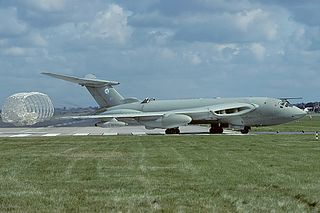
The Handley Page Victor is a British jet-powered strategic bomber developed and produced by Handley Page during the Cold War. It was the third and final V bomber to be operated by the Royal Air Force (RAF), the other two being the Avro Vulcan and the Vickers Valiant. Entering service in 1958, the Victor was initially developed as part of the United Kingdom's airborne nuclear deterrent, but it was retired from the nuclear mission in 1968, following the discovery of fatigue cracks which had been exacerbated by the RAF's adoption of a low-altitude flight profile to avoid interception, and due to the pending introduction of the Royal Navy's submarine-launched Polaris missiles in 1969.
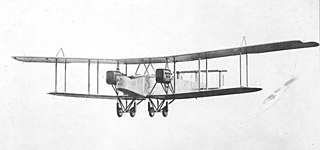
The Handley Page Type O was a biplane bomber used by Britain during the First World War. When built, the Type O was the largest aircraft that had been built in the UK and one of the largest in the world. There were two main variants, the Handley Page O/100 (H.P.11) and the Handley Page O/400 (H.P.12).

The Armstrong Whitworth A.W.38 Whitley was a British medium bomber aircraft of the 1930s. It was one of three twin-engined, front line medium bomber types that were in service with the Royal Air Force (RAF) at the outbreak of the Second World War. Alongside the Vickers Wellington and the Handley Page Hampden, the Whitley was developed during the mid-1930s according to Air Ministry Specification B.3/34, which it was subsequently selected to meet. In 1937, the Whitley formally entered into RAF squadron service; it was the first of the three medium bombers to be introduced.

The Handley Page HP.52 Hampden is a British twin-engine medium bomber that was operated by the Royal Air Force (RAF). It was part of the trio of large twin-engine bombers procured for the RAF, joining the Armstrong Whitworth Whitley and Vickers Wellington. The Hampden was powered by Bristol Pegasus radial engines but a variant known as the Handley Page Hereford had in-line Napier Daggers.

The Handley Page Halifax is a British Royal Air Force (RAF) four-engined heavy bomber of the Second World War. It was developed by Handley Page to the same specification as the contemporary twin-engine Avro Manchester.

The Bristol Bombay was a British troop transport aircraft adaptable for use as a medium bomber flown by the Royal Air Force (RAF) during the Second World War.

Royal Air Force Abingdon or more simply RAF Abingdon was a Royal Air Force station near Abingdon, Oxfordshire. It is now known as Dalton Barracks and is used by the Royal Logistic Corps.
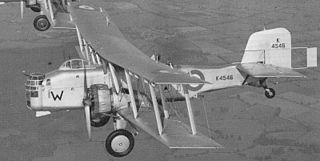
The Boulton Paul P.75 Overstrand was a twin-engine biplane medium bomber designed and produced by the British aircraft manufacturer Boulton Paul. It was the final example of a series of biplane medium bombers that had served in the Royal Air Force since the First World War, starting with the likes of the Vickers Vimy and Handley Page Type O. The Overstrand was also the first aircraft to be fitted with a fully-enclosed power-operated turret.

The Handley Page Heyford was a twin-engine biplane bomber designed and produced by the British aircraft manufacturer Handley Page. It holds the distinction of being the last biplane heavy bomber to be operated by the Royal Air Force (RAF).
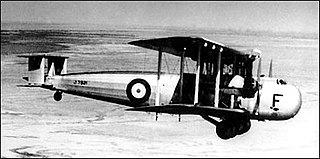
The Vickers Valentia was a British biplane bomber transport aircraft built by Vickers for the Royal Air Force. The majority built were conversions of the earlier Vickers Victoria, itself derived from the Vickers Virginia.

The Vickers Type 56 Victoria was a British biplane freighter and troop transport aircraft used by the Royal Air Force. The Victoria flew for the first time in 1922 and was selected for production over the Armstrong Whitworth Awana.
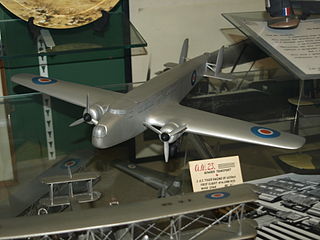
The Armstrong Whitworth A.W.23 was a prototype bomber/transport aircraft produced to specification C.26/31 for the British Air Ministry by Armstrong Whitworth Aircraft. While it was not selected to meet this specification, it did form the basis of the later Armstrong Whitworth Whitley aircraft.

The Handley Page H.P.24 Hyderabad was a twin-engine biplane heavy bomber designed and produced by the British aircraft manufacturer Handley Page. It holds the distinction of being the last wooden heavy bomber to be operated by the Royal Air Force (RAF).
Royal Air Force Dunholme Lodge or more simply RAF Dunholme Lodge was a Royal Air Force station located between the parishes of Welton and Dunholme in Lincolnshire, England.

The Handley Page H.P.43 was a three-engined biplane bomber-transport built to an Air Ministry specification. It did not fly well and the biplane configuration was out-dated at completion; the only one constructed was later turned into a monoplane and led to the Handley Page H.P.54 Harrow.
The Handley Page H.P.51 was a monoplane conversion of the earlier, unsuccessful biplane bomber-transport aircraft, the Handley Page H.P.43. The Air Ministry ordered the production variant off the drawing board as the Handley Page H.P.54 Harrow bomber.
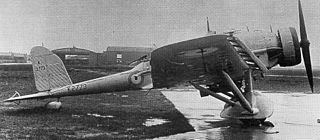
The Handley Page H.P.47 was a British single-engined low-wing monoplane built to an Air Ministry specification for a general-purpose bomber and torpedo bomber aircraft. Only one was built.






















